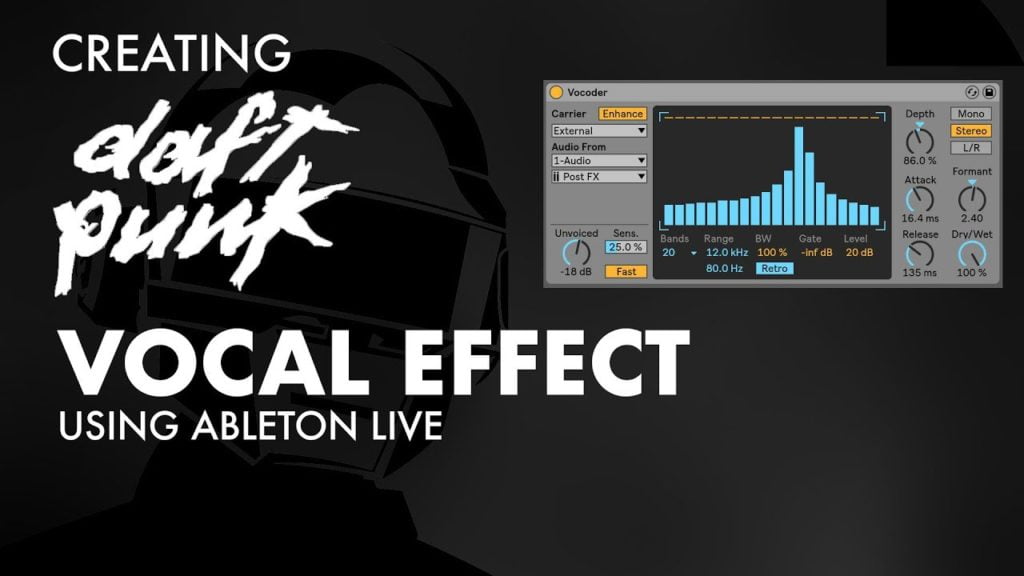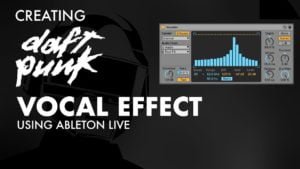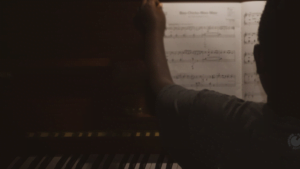Explore how you can create the Daft Punk Robotic Vocal effect using Ableton Live’s Vocoder in this easy video tutorial.
A vocoder is a category of voice codec that analyzes and synthesizes the human voice signal for audio data compression, multiplexing, voice encryption, voice transformation, etc.
The earliest type of vocoder, the channel vocoder, was originally developed as a speech coder for telecommunications applications in the 1930s. The idea being to code speech in order to reduce bandwidth (i.e. audio data compression) for multiplexing transmission. It has also been used extensively as an electronic musical instrument.
Among the most consistent uses of the vocoder in emulating the human voice are Daft Punk, who have used this instrument from their first album Homework (1997) to their latest work Random Access Memories (2013) and consider the convergence of technological and human voice “the identity of their musical project”. For instance, the lyrics of “Around the World” (1997) are integrally vocoder-processed, “Get Lucky” (2013) features a mix of natural and processed human voices, and “Instant Crush” (2013) features Julian Casablancas singing into a vocoder.
Learn how you can create the Daft Punk Vocoder/Robotic Voice effect using Ableton Live 9.
Other Musical Uses of the Vocoder.
One of the first attempts to use a vocoder in creating music was the “Siemens Synthesizer” at the Siemens Studio for Electronic Music, developed between 1956 and 1959. In 1968, Robert Moog developed one of the first solid-state musical vocoders for the electronic music studio of the University at Buffalo. In 1968, Bruce Haack built a prototype, named “Farad” after Michael Faraday. It was first featured on “The Electronic Record For Children” released in 1969 and then on his rock album, The Electric Lucifer released in 1970.
In 1970, Wendy Carlos and Robert Moog built another musical vocoder, a ten-band device inspired by the earlier vocoder designs of Homer Dudley. It was originally called a spectrum encoder-decoder and later referred to simply as a vocoder. The carrier signal came from a Moog modular synthesizer and the modulator from a microphone input. The output of the ten-band vocoder was fairly intelligible but relied on specially articulated speech. Later improved versions use a high-pass filter to let some sibilance through from the microphone; this ruins the device for its original speech-coding application, but it makes the “talking synthesizer” effect much more intelligible.
Kraftwerk’s Autobahn (1974) was one of the first successful albums to feature vocoder vocals.
Jeff Lynne of Electric Light Orchestra used it in several albums, such as “Time” (featuring the Roland VP-330 Plus MkI). ELO songs such as “Mr. Blue Sky” and “Sweet Talkin’ Woman”, both from Out of the Blue (1977), use it extensively. As does “The Diary of Horace Wimp” from the album Discovery (1979). Featured on the album are the EMS Vocoder 2000W MkI, and the EMS Vocoder (System) 2000 (W or B, MkI or II).
Giorgio Moroder made extensive use of the vocoder on the 1975 album Einzelgänger and 1977 album From Here to Eternity.
Another early example of its use is in Pink Floyd‘s song “Sheep”, from their album Animals (1977), which features a modified version of Psalm 23 recited through a vocoder. On another song on the same album, “Dogs”, the band put the sound of a barking dog through the device.
Coldplay has used the effect in some of their songs. For example, in “Major Minus” and “Hurts Like Heaven”, both from the album Mylo Xyloto (2011), Chris Martin’s vocals are mostly vocoder-processed. “Midnight”, from Ghost Stories (2014), also features Martin singing through a vocoder. The hidden track “X Marks The Spot” from “A Head Full of Dreams” has also been recorded through one.
















